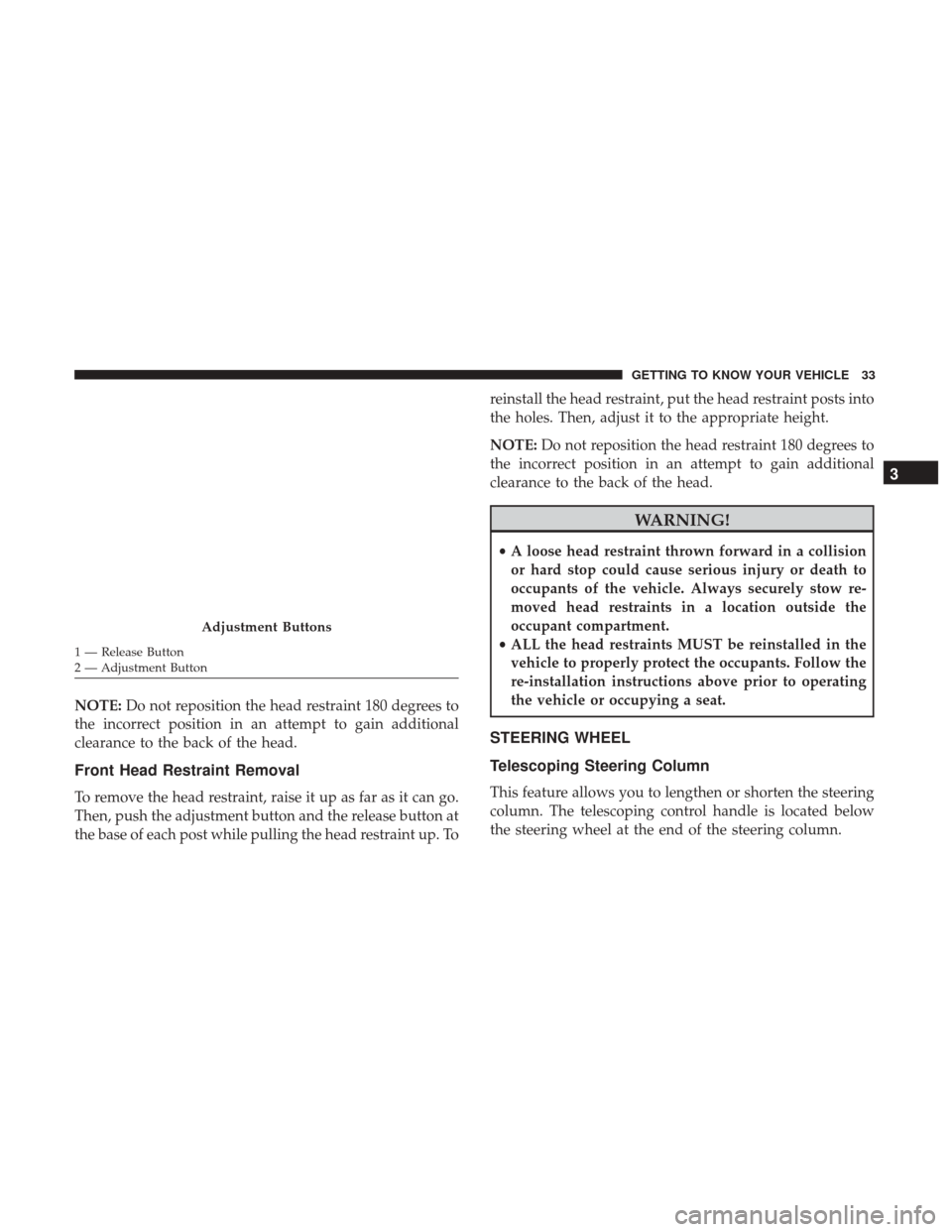Page 15 of 337

GETTING TO KNOW YOUR VEHICLE
CONTENTS
�KEYS .................................16
▫ KeyFob..............................16
� IGNITION SWITCH .......................18
▫ Mechanical Ignition Switch ................18
▫ Key-In-Ignition Reminder .................20
� SENTRY KEY ...........................20
▫ Replacement Keys .......................20
▫ General Information .....................21
� VEHICLE SECURITY ALARM — IF EQUIPPED . . .21
▫ To Arm The System ......................21
▫ To Disarm The System ....................21
▫ Rearming Of The System ..................21
▫ Security System Manual Override ............22
� DOORS ...............................22 ▫
Power Door Locks ......................22
▫ Auto Unlock Doors ......................23
▫ Automatic Door Locks ...................23
� SEATS ................................23
▫ Manual Adjustments .....................24
▫ Heated Seats — If Equipped ...............29
▫ Fold Down Tray — If Equipped .............30
▫ Adjustable Armrests — If Equipped ..........31
� HEAD RESTRAINTS ......................32
▫ Front Head Restraint Adjustment ............32
▫ Front Head Restraint Removal ..............33
� STEERING WHEEL .......................33
▫ Telescoping Steering Column ...............33
� MIRRORS ..............................343
Page 35 of 337

NOTE:Do not reposition the head restraint 180 degrees to
the incorrect position in an attempt to gain additional
clearance to the back of the head.
Front Head Restraint Removal
To remove the head restraint, raise it up as far as it can go.
Then, push the adjustment button and the release button at
the base of each post while pulling the head restraint up. To reinstall the head restraint, put the head restraint posts into
the holes. Then, adjust it to the appropriate height.
NOTE:
Do not reposition the head restraint 180 degrees to
the incorrect position in an attempt to gain additional
clearance to the back of the head.
WARNING!
• A loose head restraint thrown forward in a collision
or hard stop could cause serious injury or death to
occupants of the vehicle. Always securely stow re-
moved head restraints in a location outside the
occupant compartment.
• ALL the head restraints MUST be reinstalled in the
vehicle to properly protect the occupants. Follow the
re-installation instructions above prior to operating
the vehicle or occupying a seat.
STEERING WHEEL
Telescoping Steering Column
This feature allows you to lengthen or shorten the steering
column. The telescoping control handle is located below
the steering wheel at the end of the steering column.
Adjustment Buttons
1 — Release Button
2 — Adjustment Button
3
GETTING TO KNOW YOUR VEHICLE 33
Page 36 of 337

To unlock the steering column, pull the control handle up.
To lengthen or shorten the steering column, pull the
steering wheel outward or push it inward as desired. To
lock the steering column in position, push the control
handle down until fully engaged.
WARNING!
Do not adjust the steering column while driving.
Adjusting the steering column while driving or driv-
ing with the steering column unlocked, could cause the
driver to lose control of the vehicle. Failure to follow
this warning may result in serious injury or death.
MIRRORS
Inside Day/Night Mirror — If Equipped
A two-point pivot system allows for horizontal and vertical
adjustment of the mirror. Adjust the mirror to center on the
view through the rear window.
Headlight glare can be reduced by moving the small
control under the mirror to the night position (toward the
rear of the vehicle). The mirror should be adjusted while
set in the day position (toward the windshield).
Telescoping Control Handle
34 GETTING TO KNOW YOUR VEHICLE
Page 70 of 337

WARNING!
A hot engine cooling system is dangerous. You or
others could be badly burned by steam or boiling
coolant. You may want to call an authorized dealer for
service if your vehicle overheats. If you decide to look
under the hood yourself, see “Servicing And Mainte-
nance.” Follow the warnings under the Cooling System
Pressure Cap paragraph.
CAUTION!
Driving with a hot engine cooling system could dam-
age your vehicle. If the temperature gauge reads “H,”
pull over and stop the vehicle. Idle the vehicle with the
air conditioner turned off until the pointer drops back
into the normal range. If the pointer remains on the
“H,” turn the engine off immediately and call an
authorized dealer for service.5. Fuel Gauge
•The pointer shows the level of fuel in the fuel tank
when the ignition switch is in the ON/RUN position.
•
The fuel pump symbol points to the side of the
vehicle where the fuel door is located.
INSTRUMENT CLUSTER DISPLAY
Your vehicle may be equipped with an instrument cluster
display, which offers useful information to the driver. With
the ignition in the STOP/OFF mode, opening/closing of a
door will activate the display for viewing, and display the
total miles, or kilometers, in the odometer. Your instrument
cluster display is designed to display important informa-
tion about your vehicle’s systems and features. Using a
driver interactive display located on the instrument panel,
your instrument cluster display can show you how sys-
tems are working and give you warnings when they are
not. The steering wheel mounted controls allow you to
scroll through the main menus and submenus. You can
access the specific information you want and make selec-
tions and adjustments.
68 GETTING TO KNOW YOUR INSTRUMENT PANEL